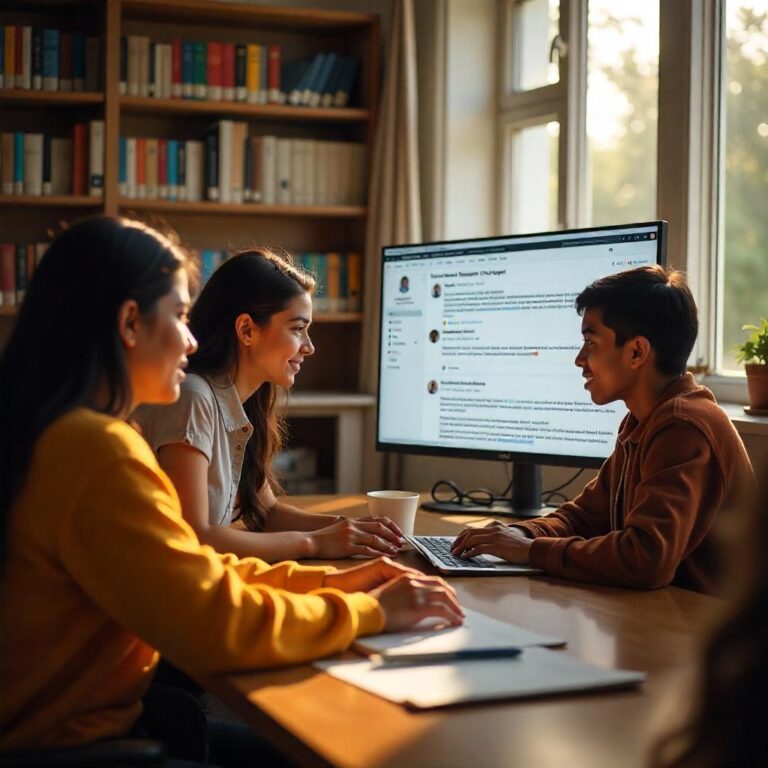How To Make Online Learning More Interactive For Kids
Making online learning more interactive for kids is key to keeping them engaged, motivated, and focused. Children often struggle with the passive nature of traditional online learning, especially if they’re sitting through long lectures or working through materials that aren’t stimulating. Here are some strategies to make online learning more interactive and fun for kids:
1. Incorporate Gamification
-
Interactive Quizzes and Challenges: Use online quiz platforms like Kahoot!, Quizizz, or Google Forms to create fun and competitive quizzes. You can also introduce friendly competitions, where kids can earn points, badges, or rewards for completing tasks, answering questions correctly, or demonstrating good participation.
-
Reward System: Establish a point system or a reward chart to keep kids motivated. Offer rewards for completing assignments on time, showing improvement, or participating actively in class discussions.
-
Educational Games and Apps: Many educational apps and games are designed to teach kids various subjects through play. Apps like Duolingo (for language learning), Prodigy (math), or Minecraft Education Edition (for creative and problem-solving skills) can engage kids in subject-specific learning through games.
2. Use Interactive Tools and Platforms
-
Virtual Whiteboards: Platforms like Jamboard, Miro, or Padlet allow kids to interact with the content visually. They can write, draw, and collaborate with peers in real-time. These tools make lessons more hands-on and encourage creativity.
-
Breakout Rooms: If you’re using a video conferencing tool like Zoom, use breakout rooms for small group discussions. In these smaller, more intimate settings, kids feel more comfortable participating and can collaborate with their peers on projects or tasks.
-
Interactive Polls and Surveys: Incorporate live polls or surveys during lessons to engage kids and get immediate feedback. Tools like Mentimeter or Slido allow for easy integration of live polls, word clouds, and quizzes.
3. Incorporate Visuals and Multimedia
-
Videos and Animations: Use educational videos or animations to explain concepts. Platforms like YouTube (with kid-friendly channels), Khan Academy, or PBS Kids offer engaging and visually stimulating videos on various topics. These visual aids break down complex information and make learning more engaging.
-
Interactive Presentations: Tools like Google Slides or Microsoft PowerPoint can be made more interactive by adding clickable links, embedded videos, and interactive elements. You can create quizzes or games within the slides to keep kids engaged throughout the lesson.
-
Virtual Field Trips: Many museums, parks, and historical sites offer virtual tours. Kids can “visit” places like the Louvre, NASA, or a coral reef from the comfort of their homes. These virtual trips can be incorporated into lessons to make learning more immersive.
4. Encourage Hands-On Learning
-
DIY Projects and Experiments: Incorporate simple hands-on activities or science experiments that kids can do at home with common materials. For example, a lesson on the water cycle can be paired with an experiment where kids create a mini-water cycle in a bag.
-
Arts and Crafts: For creative subjects like art, encourage kids to use materials they already have at home to create projects. Kids can show off their work to the class via video or take photos and share them in class discussions.
-
Cooking and Baking: For lessons in measurement, math, or even cultural studies, incorporate cooking projects. Kids can learn fractions, ratios, and measurements while preparing recipes.
5. Promote Active Participation
-
Discussion Prompts and Questions: Instead of just lecturing, prompt kids to discuss topics by asking open-ended questions or encouraging them to share their thoughts. Use strategies like “think-pair-share,” where kids think about a question, pair up with a partner to discuss it, and then share with the class.
-
Student Presentations: Allow kids to take turns presenting what they’ve learned. It could be a presentation about a research topic, a creative project, or even a summary of a lesson. Giving students the opportunity to lead parts of the lesson fosters engagement and reinforces their learning.
-
Peer Teaching: Assign pairs or small groups to explain concepts to each other. This “teaching” method helps kids reinforce their understanding and build confidence in what they’ve learned.
6. Encourage Real-World Connections
-
Connect Learning to Real-Life Situations: Help kids understand how what they’re learning applies to the real world. For example, a math lesson can include budgeting for a trip, a science lesson might explore how engineering relates to building a house, or a history lesson can involve investigating local landmarks.
-
Guest Speakers or Virtual Visits: Invite experts or professionals to virtually visit the class. A local scientist, artist, or business owner can give a talk about their work, making the learning experience feel more connected to the real world.
-
Project-Based Learning: Instead of traditional assignments, use project-based learning where kids research, create, and present projects based on real-world scenarios. For example, they could create a model of a sustainable city, develop an invention, or write and produce a short film.
7. Foster Collaborative Learning
-
Group Work: Assign group projects where students can collaborate and use their strengths to complete a task. Digital tools like Google Docs or Trello allow for easy collaboration and allow kids to see each other’s work in real-time.
-
Classroom Challenges: Organize team-based challenges where kids can work together to solve problems or complete tasks. For instance, they might work as a team to solve a math puzzle, create a poem, or design a story together.
-
Buddy Systems: Pair kids up for buddy learning sessions. They can help each other with assignments, share ideas, and check in on each other’s progress, making the learning experience more interactive and collaborative.
8. Use Interactive Feedback
-
Instant Feedback: Give immediate feedback on assignments, quizzes, and activities so that kids know where they stand and can make improvements right away. Platforms like Google Classroom and Edmodo offer instant feedback tools that allow for easy grading and comments.
-
Peer Feedback: Encourage kids to give feedback to each other in a constructive way. This not only helps them learn from each other but also promotes social skills and builds a sense of community.
9. Incorporate Movement and Physical Activity
-
Brain Breaks: Incorporate movement-based brain breaks during online lessons to give kids a mental reset. These can be short activities like dancing, stretching, or jumping jacks, which are especially helpful during longer classes.
-
Interactive Learning Apps: Some apps incorporate movement into learning. For instance, apps like GoNoodle or Cosmic Kids Yoga offer fun, movement-based activities that also promote learning.




